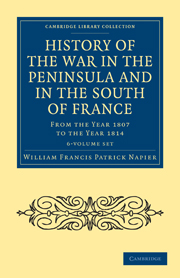 I have been to Wales on only one occasion, and that was a day trip to from Cambridge to St Asaph in my relatively sprightly youth. I feel that this did not really do justice to the Principality, and that I should go back some time – and I have to say that Wales always looks very pretty when viewed (as Jenny Lind must have done) from the back of the Malvern Hills. (I do not mean this in the spirit of Dr Johnson on ‘the noblest prospect a Scotchman ever sees’, either.)
I have been to Wales on only one occasion, and that was a day trip to from Cambridge to St Asaph in my relatively sprightly youth. I feel that this did not really do justice to the Principality, and that I should go back some time – and I have to say that Wales always looks very pretty when viewed (as Jenny Lind must have done) from the back of the Malvern Hills. (I do not mean this in the spirit of Dr Johnson on ‘the noblest prospect a Scotchman ever sees’, either.)
Wales did not get very good reviews from over the border in the late eighteenth century. It was picturesque, and therefore should have been a magnet for landscape artists. It was also full of geology, and Adam Sedgwick (1785-1873), Woodwardian Professor of Geology at Cambridge, used to take parties of students to north Wales in the summer to fire their geological imaginations: famously, one of his pupils was Charles Darwin. It was Sedgwick who named the Cambrian layer (and epoch of geological time) after the Romans’ name for Wales, though at the time this was a source of great controversy: the professor and the ‘gentleman amateur’ Roderick Impey Murchison, former co-authors, fell out over where Sedgwick’s Cambrian ended and Murchison’s Silurian began.
William Gilpin had, in his various volumes of Observations, Relative Chiefly to Picturesque Beauty published during the 1780s and 790s, urged the English gentleman to take a greater interest in the landscape of his own country. But, for dilettanti and artists alike, the wilder parts of Wales, the Lake District (where Sedgwick also worked, and published a visitors’ guide in collaboration with William Wordsworth and others) and Scotland were not traveller-friendly. They did not have the charms, to say nothing of the weather and the classical ruins, of Italy and Greece. (I wish I could remember which pre-Romantic traveller it was who, crossing one of the Lake District passes, drew his carriage blinds against the bleakness of the view.) And the natives were not picturesque either.
The consequence was that although there was an increasing demand for paintings and engravings of romantic peaks, ruins, waterfalls etc., there was a reluctance among the artistic fraternity to set out into the wet, cold and mud, and to engage with the incomprehensible aborigines. John Boydell, the famous publisher of engravings and prints of famous paintings, lamented the inability of the artists he sent out to capture Welsh views to move beyond the relatively well trodden area of Snowdon, ‘on the ground of the difficulty in which a stranger, unacquainted with the language or the country, involved himself, the moment that he quitted the high roads, and plunged into the intricacies of the mountains’.
Step forward Edward Pugh (1763–1813), the son of a Ruthin barber. He became a painter of both portraits and landscapes (though he refers self-deprecatingly in the preface to his masterpiece to his ‘moderate talent as an artist’), and although he seems to have been based mostly in Wales and Chester, he knew Boydell, who suggested to him that he would be ideally placed, as a native, to boldly go into the dangerous regions where the soft London artists feared to tread. Pugh was unable to take up the suggestion at the time, but in the spring of 1804 he decided not merely to go and paint the landscape, but also to write down his observations of people, antiquities and travelling conditions, and the anecdotes accumulated on the journey, noting that previous accounts of north Wales ‘have generally been undertaken by complete strangers to those people, their manners and customs; and who, therefore, could not possibly avoid numerous inaccuracies’.
The resulting book, Cambria Depicta, took nine years to complete, and involved ‘travelling as a pedestrian, between two and three thousand miles, over one of the roughest districts of Great Britain’. Sadly, as a footnote to the preface relates, ‘The Author of this Valuable Work is no more. He died at Ruthin in June, 1813’, a month after the date of the preface. To find out more about Pugh’s life and works, you need go no further than John Barrell’s new biography, Edward Pugh of Ruthin. We were delighted to be asked by Professor Barrell if the Cambridge Library Collection would be able to reissue Cambria Depicta: sadly, we were not able to reproduce the delicate colour of Pugh’s images in the printed book, but all of them can be seen online by clicking ‘Resources Available’ here.
The text is a lively and entertaining accompaniment to the images, and indeed in some cases it is vital to elucidate the subjects – see for example ‘The Infant Hercules’, or ‘Mary Thomas, the fasting woman’, or especially ‘The perilous situation of Robert Roberts’. Other images are of more conventionally picturesque castles and churches, rivers and mountains, though one surprising picture (to me, anyway) is of Mrs Piozzi’s home, Bryn Bella – it is described in the ODNB as a ‘villa’, but what Pugh depicts is closer in scale to a stately pile. But Pugh’s stated intention of presenting the people of north Wales as honest, kind and welcoming is carried through, with many charming anecdotes about the hospitality of sometimes very poor people to passing strangers.
There was a certain suspicion of foreigners coming into the area and ‘writing things down’ – it was after all a time of war, with rumours of spies abounding, and ‘the last invasion of Britain’ (a shambolic attempt by the French at Fishguard) had happened on Welsh soil as recently as 1797. When the strangers could not speak Welsh, and where the Welsh had not enough experience of English to recognise the language, there were occasional contretemps which Pugh records with amusement. More than once, he himself pretended to have no knowledge of his native tongue in order to hear what the suspicious natives thought about him: he would then confound them by speaking in Welsh, which naturally convinced everyone that he could not possibly be a spy.
The image chosen for our cover is ‘A Fall of Rocks’, showing the artist perched on a rock with his sketch-pad, dwarfed by a landslip which has obliterated any vegetation in its path – the whole thing executed in shades of brown, relieved only by the jaunty blue of the artist’s coat. Pugh gives this as a possible hazard to the wandering artist, but reassures that ‘very few examples of the kind occur in a century’. By contrast with this rather bleak landscape, there are many quirky images which are explained by Pugh’s genial commentary, and the breadth of his interests is wide – the saint who protects hares, the one who made a stream run with milk to feed the poor, the 108-year-old shoemaker, the ‘three most disgraceful men in Britain’, the possible birthplace of Mrs Jordan, the funeral customs of the Welsh… Pugh acknowledges the works of Thomas Pennant as the source for many of the facts of Welsh history in his account, but the great charm and interest of the book lie in his illustrations and in his own descriptions of what he saw and encountered on his epic journey.
Caroline



Pingback: Taking The Waters | Cambridge Library Collection Blog
Pingback: A Memoir of Gabriel Beranger | Cambridge Library Collection Blog
Pingback: Tulipomania | Cambridge Library Collection Blog